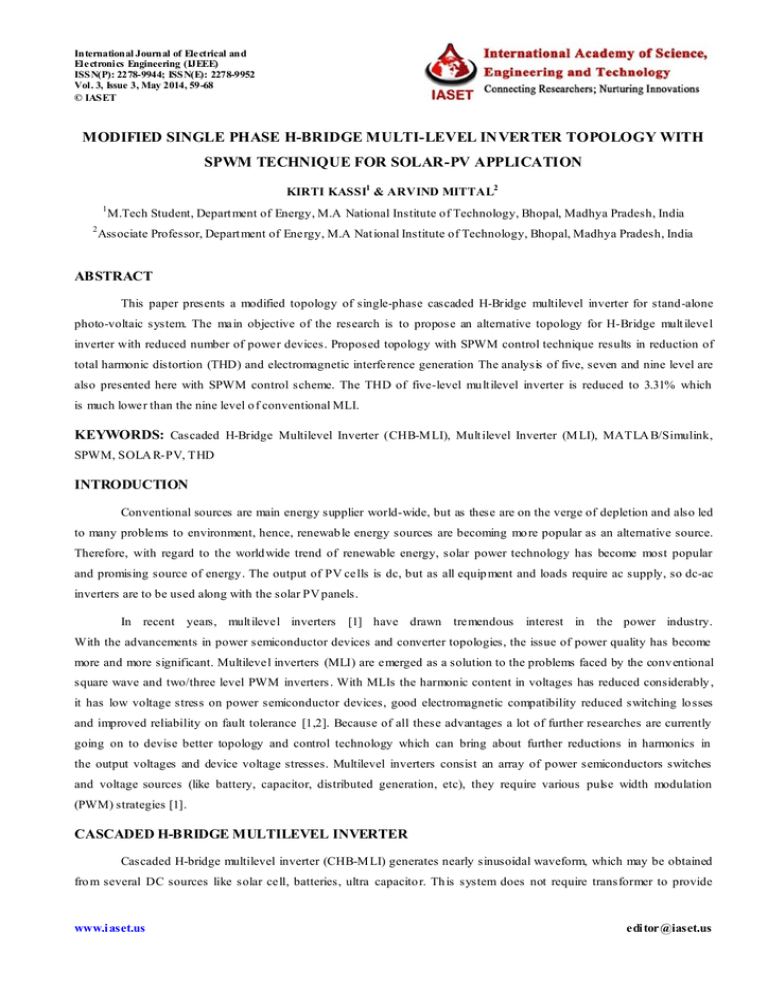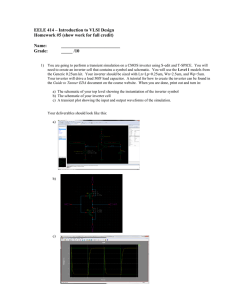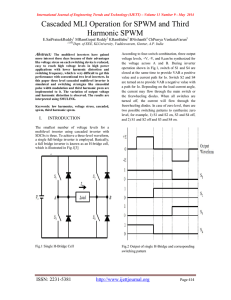modified single phase h-bridge multi
advertisement

International Journal of Electrical and Ele ctronics Engineering (IJEEE) ISSN(P): 2278-9944; ISSN(E): 2278-9952 Vol. 3, Issue 3, May 2014, 59-68 © IASET MODIFIED SINGLE PHASE H-BRIDGE MULTI-LEVEL INVERTER TOPOLOGY WITH SPWM TECHNIQUE FOR SOLAR-PV APPLICATION KIRTI KASSI1 & ARVIND MITTAL2 1 2 M.Tech Student, Depart ment of Energy, M.A National Institute of Technology, Bhopal, Madhya Pradesh, India Associate Professor, Depart ment of Energy, M.A Nat ional Institute of Technology, Bhopal, Madhya Pradesh, India ABSTRACT This paper presents a modified topology of single-phase cascaded H-Bridge multilevel inverter for stand-alone photo-voltaic system. The main objective of the research is to propose an alternative topology for H-Bridge mult ilevel inverter with reduced number of power devices. Proposed topology with SPWM control technique results in reduction of total harmonic distortion (THD) and electromagnetic interference generation The analysis of five, seven and nine level are also presented here with SPWM control scheme. The THD of five-level mu lt ilevel inverter is reduced to 3.31% which is much lower than the nine level o f conventional MLI. KEYWORDS: Cascaded H-Bridge Multilevel Inverter (CHB-M LI), Mult ilevel Inverter (M LI), MATLA B/Simulink, SPWM, SOLA R-PV, THD INTRODUCTION Conventional sources are main energy supplier world-wide, but as these are on the verge of depletion and also led to many problems to environment, hence, renewab le energy sources are becoming mo re popular as an alternative source. Therefore, with regard to the world wide trend of renewable energy, solar power technology has become most popular and promising source of energy. The output of PV cells is dc, but as all equip ment and loads require ac supply, so dc-ac inverters are to be used along with the solar PV panels. In recent years, mult ilevel inverters [1] have drawn tremendous interest in the power industry. With the advancements in power semiconductor devices and converter topologies, the issue of power quality has become more and more significant. Multilevel inverters (MLI) are emerged as a solution to the problems faced by the conv entional square wave and two/three level PWM inverters . With MLIs the harmonic content in voltages has reduced considerably , it has low voltage stress on power semiconductor devices, good electromagnetic compatibility reduced switching lo sses and improved reliability on fault tolerance [1,2]. Because of all these advantages a lot of further researches are currently going on to devise better topology and control technology which can bring about further reductions in harmonics in the output voltages and device voltage stresses. Multilevel inverters consist an array of power semiconductors switches and voltage sources (like battery, capacitor, distributed generation, etc), they require various pulse width modulation (PWM) strategies [1]. CASCADED H-BRIDGE MULTILEVEL INVERTER Cascaded H-bridge multilevel inverter (CHB-M LI) generates nearly sinusoidal waveform, which may be obtained fro m several DC sources like solar cell, batteries, ultra capacito r. Th is system does not require transformer to provide www.i aset.us edi tor@iaset.us 60 Kirti Kassi & Arvind Mittal isolation and do not require flying capacitors or clamping diodes. It co mes with an advantage of smaller dv/dt stress, it requires least number of co mponents and no high rated capacitors and diodes are required. Also the cascaded MLI is best suited for solar photo-voltaic applications. M1 M2 VDC M3 M4 LOAD M1' M2' M3' M4' VDC Figure 1: Single Phase Structure of Cascaded Multilevel Inverter Each single H-b ridge converter is associated with a single DC source. Modules are connected in series with each other. Through different comb inations of the four switches it gives five different voltage outputs of +2V, +V, 0, -V, -2V. Output voltage of ‘m’ level inverter is the sum of a ll individual inverter outputs. MODIFIED CASCADED MULTI-LEVEL INVERTER The modified M LI consists of less number of power devices when compared with conventional cascaded H-Bridge mu ltilevel inverter. The cost of the system reduces significantly because of the reduction of devices. Hence, it looks quite attractive and an appropriate one for industrial applications. In the proposed topology the output voltage level is defined by m=2N+1, where N is the number of DC sources The number of devices required is given by d=2N+2, where N is the number of DC sources So, for five-level inverter only six power devices are required and hence for seven and nine level, only eight and ten power devices are required respectively. For the proposed topology, its just needed to add only two more device for every rise in level. So the initial cost of the system gets reduced. The comparison of devices used in conventional cascaded H-Bridge and the modified cascaded H-Bridge M LI is tabulated in table 1 Table 1: S wi tches Comparison B/W Cascaded and Proposed MLI Inverter Type CASCADED H-BRIDGE M LI MODIFIED CASCA DED M LI Fi ve 8 6 Seven 12 8 Nine 16 10 The power circuit of five-level modified cascaded H-Bridge M LI is shown in figure 2 Impact Factor (JCC): 2.4886 Index Copernicus Value (ICV): 3.0 Modified Single Phase H-Bridge Multi-Level Inverter Topology with SPWM Technique for Solar-PV Application 61 M1 M2 Vdc LOAD M3 M4 Vdc M5 M6 Figure 2: Modified Cascaded H-Bri dge MLI Topol ogy Switching Conditions In this circuit diagram M 1 and M2 are conducting for 120o and M3, M4, M 5 and M6 are conducting for 60o . The switching pattern of the MOSFETS and the output voltage of single phase modified five-level multilevel inverter is tabulated in table 2. For getting +12V output M1 and M4 are ON and for +24V shown in figure 3(a), output switch M1 and M6 are ON as shown in figure 3(b). Similarly for -12V output switches M2 and M3 are ON and for -24V shown in figure 3(c) output M2 and M5 switches are ON as shown in figure 3(d). In the interval of 0o to 30o , 150o to 210o and 330o to 360o the output voltage is 0V and all the switches are OFF. The expected output voltage waveform of modified MLI is shown in figure 4. Table 2: S wi tching States of Proposed MLI www.i aset.us edi tor@iaset.us 62 Kirti Kassi & Arvind Mittal Figure 3: Working of Proposed Circuit in Various Modes Figure 4: Output Voltage Waveform of Modi fied MLI CONTROL TECHNIQUES FOR MLI The switching losses and harmonic reduction are basically depends on the modulation scheme used to control the inverter. One of the most widely used classifications is based upon the open loop and closed loop concept. The brief controlling schemes are described by the block diagram shown in figure 5. PWM scheme is further classified into sinusoidal, vector and sigma delta schemes. The SPWM is one of the most widely used modulation scheme among all present schemes. In SPWM a sinusoidal reference voltage waveform is co mpared with triangular carrier waveform to generate gate pulses for switching of power devices of inverter. Power dissipation is the most important factor in h igh power applications and hence the SPWM control method is proposed to minimize the switching losses. Further th e scheme is divided into three more parts i.e phase disposition PWM, phase opposition disposition PWM and alternate phase opposition disposition PWM [11]. Impact Factor (JCC): 2.4886 Index Copernicus Value (ICV): 3.0 63 Modified Single Phase H-Bridge Multi-Level Inverter Topology with SPWM Technique for Solar-PV Application Figure 5: Control Schemes of MLI SIMULATION RESULTS The simulation of the modified single phase five-level CHB-M LI is done in MATLAB and the simulink model is shown in figure 6. The output voltage waveform is shown in figure 7 and it is observed that the THD is 31.92% . Figure 6: MATLAB Model of Modified Single Phase Fi ve-Level CHB-MLI Figure 7: Output Voltage Waveform for Single Phase Fi ve -Level Modified CHB -MLI www.i aset.us edi tor@iaset.us 64 Kirti Kassi & Arvind Mittal The THD can be reduced drastically by applying the SPWM control scheme. The simulat ion model fo r the same is shown in figure 8 and output voltage waveform is shown in figure 9. It is observed that with the implementation of SPWM control scheme the THD has reduced to 3.31%. (a) Complete System wi th SPWM Control for Fi ve-Level MLI (b) Modulator Block of Fi ve-Level MLI Figure 8: Simul ation Model for Fi ve-Level Modified MLI wi th SPWM Control Figure 9: Output Voltage Waveform for Single Phase Fi ve -Level Modified H-Bri dge MLI wi th SPWM Scheme Similarly, the simulat ion is done for seven-level modified M LI. The simulat ion model is shown in figure 10 and output voltage waveform is shown in figure 11. It is observed that with the imp lementation of SPWM control scheme the THD has reduced to 2.35%. (a) Complete System wi th SPWM Control for Seven-Level MLI (b) Modulator Bl ock of Seven-Level MLI Figure 10: Simulation Model for Seven-Level Modi fied MLI Impact Factor (JCC): 2.4886 Index Copernicus Value (ICV): 3.0 65 Modified Single Phase H-Bridge Multi-Level Inverter Topology with SPWM Technique for Solar-PV Application Figure 11: Output Vol tage Waveform for Single Phase Seven-Level Modi fied H-Bri dge MLI with SPWM Scheme Likewise, the THD is observed to be 1.84% fo r nine level modified MLI. The output voltage waveform is shown in figure 13 and simu lation model is shown in figure 12. (a) Complete System wi th SPWM Control for Nine -Level MLI (b) Modul ator Block of Nine -Level MLI Figure 12: Simulation Model for Ni ne-Level Modified MLI Figure 13: Output Vol tage Waveform for Single Phase Nine -Level Modi fied H-Bri dge MLI wi th SPWM Scheme The comparison of THD of five-level, seven-level and nine-level of modified Cascaded H-bridge M LI with and without using the controlling scheme is shown in Table 3. Table 3: Comparison of THD (% ) without and with Control Scheme Levels Five-level Seven-level Nine-level www.i aset.us THD % (without SPWM Control) 31.92% 25.46% 22.03% THD % (with SPWM Control) 3.31% 2.35% 1.84% edi tor@iaset.us 66 Kirti Kassi & Arvind Mittal APPLICATION OF PROPOSED SYSTEM IN SOLAR PV The modified five-level single-phase CHB mu lti-level inverter is used to convert the dc voltage obtained from the solar panels for feeding the ac loads. The two solar panels of 40V output are connected as the input to the inverter and SPWM control scheme is implemented to get the output near to sine wave. The simulation model o f the a bove system is shown in figure 14. The circu it is tested for resistive load and the output voltage waveform is shown in figure 15. (a) Complete System Simulated with PV Array (b) Modulator Bl ock of Inverter Figure 14: SPWM Controlled Proposed System for Sol ar PV Figure 15: Output Vol tage Waveform for Single Phase Fi ve-Level Modi fied H-Bri dge MLI with PV as a Source Impact Factor (JCC): 2.4886 Index Copernicus Value (ICV): 3.0 67 Modified Single Phase H-Bridge Multi-Level Inverter Topology with SPWM Technique for Solar-PV Application CONCLUSIONS The simu lation of the single phase modified cascaded H-bridge M LI is done successfully by using SPWM (PD) scheme in MATLAB/simulink. The modified MLI with SPWM scheme offer imp roved output waveforms with lower THD i.e 3.31% with resistive load as compared to 31.92% without control scheme. The research also shows the reduction of initial cost and complexity due to reduction in number of devices required. With the increase in levels the number of switches required is very less compared to conventional MLI. The proposed MLI is successfully simulated for Solar PV applications. REFERENCES 1. Murugesan. G, Jagabar Sathik.M , Praveen.M “A New Mult ilevel Inverter Topology Using Less Number of Switches” International Journal of Engineering Science and Technology (IJEST), Vo l. 3 No. 2 Feb 2011 . 2. M. Kavitha, A. Arunkumar, N. Goku lnath , S. Arun, “New Cascaded H-Bridge Multilevel Inverter Topology with Reduced Number of Switches and Sources”, IOSR Journal of Electrical and Electronics Engineering (IOSR-JEEE ), Volu me 2, Issue 6 (Sep-Oct. 2012), PP 26-36. 3. Pablo Lezana, José Rodríguez, Diego A. Oyarzún, “Cascaded Multilevel Inverter with Regeneration Capability and Reduced Number of Switches”, IEEE Transactions On Industrial Electronics, Vol. 55, No. 3, March 2008. 4. M. R. Banaei, E. Salary, “New Multilevel Inverter with Reduction of Switches and Gate Driver”, Proceedings of ICEE 2010, May 11-13, 2010. 5. Sun Xing-tao, Gao Sheng-wei, “Research on Topology and PWM Control Method of a Novel Cascaded Multilevel Inverter”, Proceedings of the 2010 IEEE International Conference on Mechatronics and Automation, August 4-7, 2010. 6. Ebrah im Babaei, Seyed Hossein Hosseini, “New Multilevel Converter Topology with Minimu m Nu mber of Gate Driver Circuits”, International Sy mposium on Power Electronics, Electrical Drives, Automation and Motion, 2008. 7. P. Thongprasri, “A 5-Level Three-Phase Cascaded Hybrid Multilevel Inverter”, International Journal of Co mputer and Electrical Engineering, Vo l. 3, No. 6, December 2011. 8. K.K. Gupta S. Jain, “Topology For Multilevel Inverters To Attain Maximu m Nu mber of Levels fro m Given DC Sources”, IET Po wer Electronics, 6th May 2011 9. Tamer H. Abdelhamid, “Reduced PWM Harmonic Distortion for a New Topology of Multilevel Inverters”, Asian Power Electronics Journal, Vo l. 1, No. 1, Aug 2007. 10. Surin Kho mfo i, Nattapat Praisuwanna, “A Hybrid Cascaded Multilevel Inverter Application for Renewab le Energy Resources Including a Reconfiguration Technique”, Energy Conversion Congress and Exposition (ECCE), 2010 IEEE. 11. Ilhami Co lak, Ersan Kabalci, Ramazan Bayindir, “Rev iew of Multilevel Vo ltage Source Inverter Topologies And Control Schemes”, Energy conversion and management, Elsevier, 2010 www.i aset.us edi tor@iaset.us






